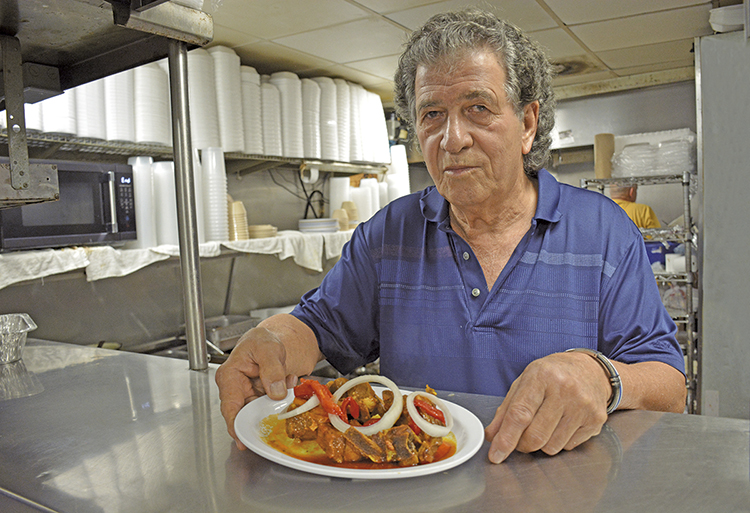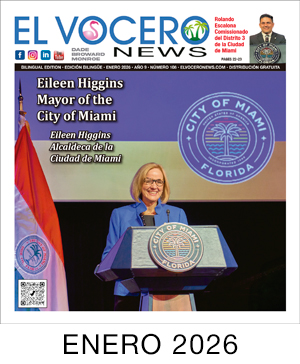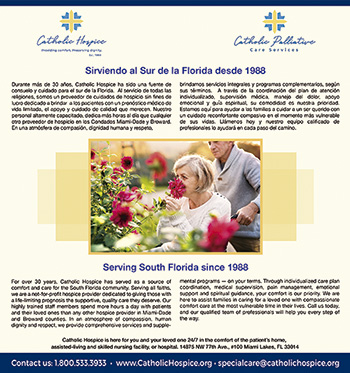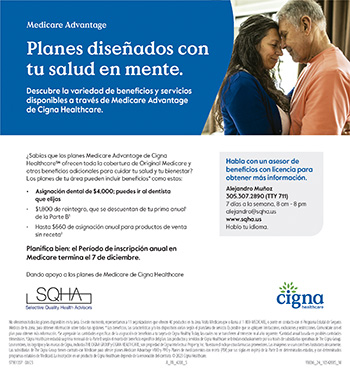Jesus Hernandez
Greater Miami´s history is full of remarkable experiences about vision and improvement and 25 years of Casa Marín restaurant in Hialeah is a good example of work, effort, and tenacity.
“We opened the restaurant in 1999. It was a small cafeteria, and from the first day we decided to service real Cuban food. Cuban flavor and cooking style for a popular Cuban restaurant,” chef and owner of the famous restaurant, Diosdado Marín, exclaimed.
But before fame came, Marín had to gather recipes and add a touch of his own. Back then, social media did not exist, and the new business could not afford to pay for advertising.
One day, Marín made 20 steak sandwiches, very much in his style, with meat very well marinated on top of the chips and tomatoes, “to taste it better”; and distributed them throughout the neighborhood in Hialeah.
He did something similar with the Cuban sandwich. “If you put pickled cucumber on the bottom, you’re not going to get the same taste. Many people will tell you ‘It doesn’t have cucumber.’ And yet there is pickled cucumber, but it is at the bottom, and it doesn’t taste the same,” he explained.
“I put three slides on top. You enjoy it more on your palate. “Yes, there are a lot of secrets about cooking, many little things like that,” he noted.
Another day, Marín promoted his roast suckling pig with Moro rice and cassava, and thus, with the dish in hand, low prices, and word-of-mouth advertising, he managed to get people to know the new Casa Marín restaurant.
“We worked extremely hard, and we created dishes that only Casa Marín can make right. Other restaurants might make something similar, but they are ‘copies’,” he highlighted.
Signature dishes
And, the first signature dish was born, with a picaresque name, although accidental, ‘La cosita de Marín’, Marín’s little thing.
“I was sitting at the counter, and I said, ‘I’m going to make something to eat’. I chose a chicken steak, pounded it, and marinated it with lemon, garlic, and salt. I put some ham and rolled it into a banana shape, wrapped it with bacon, and put it in the oven, and then I put it in the fryer just to brown it. I cut it into pieces. It turned out beautiful. It was perfect, as they say, perfect for a photo,” he explained.
“Everyone loved it!” he exclaimed.
At that very moment, a pair of customers arrived and they didn´t know what to order. “We offered them a bite of what I just made, and the lady said, ‘I want to order that little thing Marín made’, and that is the name we gave to the dish, ‘Marín’s little thing ‘. That’s how the name came out,» he said with a laugh.
“The dish caught on,” it became popular, “I tried to make it known through the means I had. Back then there was no Facebook, so I distributed flyers around Hialeah, and word of mouth publicity helped a lot,” he recalled.
Variety
In addition to Cuban food and signature dishes, there are dishes that celebrate the cuisine from Hispanic’s Motherland, Spain, in the style of Marín.
Indeed, a good part of Cuban cuisine has its roots in Spain. “We have the Galician soup, which is very popular, as well as the fabada and other dishes that I make, such as ‘Madrid little pork’, which is a pork steak stuffed with fried chickpeas, chorizo, ham and rolled in bacon, as well as the Catalan styles chicken fricassee, which is delicious as well,” he stated.
How did Marin become a chef?
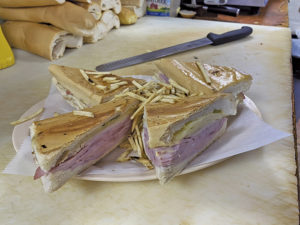 Marín arrived from Cuba in 1990. “I held a major degree in Sports, but ‘validating’ the degree and working on it here was exceedingly difficult. I needed to speak English. And, as I arrived with my wife and two small children, I had to work to earn money to support the family,” he emphasized.
Marín arrived from Cuba in 1990. “I held a major degree in Sports, but ‘validating’ the degree and working on it here was exceedingly difficult. I needed to speak English. And, as I arrived with my wife and two small children, I had to work to earn money to support the family,” he emphasized.
Marín began washing dishes in a restaurant. Later, he worked at the Latin American chain restaurants. “I learned a lot in the kitchen. I served dishes, but I have always been a person who likes to see beyond. I helped the cook, and I learned how to cook,” he recalled.
In Cuba, Marín had a certain notion of cooking. “But it is not the same. Over there you make split peas soup with onion and salt, but here we have meat, chorizo, and spices, and we need to learn how to combine the ingredients to get the perfect touch,” he added.
25 years
According to data from statistics firm Xmap, in Miami-Dade there are nearly 8,800 food businesses, and this number places this metropolitan area among the leading areas per capita in the Nation. Therefore, gastronomy is an extremely competitive industry in South Florida.
In fact, Greater Miami holds the second largest inventory of international restaurants in the United States, only surpassed by New York.
“It is an exceedingly difficult business. Only 15 or 20 restaurants, out of 100, manage to survive,” he said.
With the typical Cuban ‘ventanita,’ window, for coffee and take-out orders, Casa Marín offers a counter and well-placed tables that accommodate up to 55 clients in a family atmosphere that makes the place precisely popular.
“I say, in addition to the quality and price of the food, the relationship between owner or manager, employee and customer is essential. Bringing a customer to the restaurant is extremely hard, but losing them is extremely easy,” he affirmed.
Proof of this is the loyalty of several employees, who return as clients even when they work elsewhere.
“You must look at the client as part of the family. Please him within the restaurant rules,” he stated.
How can you do that? “If the customer wants the tomato cut into cubes and not into slices as most of us do, we cut it in dice for the client. If they want the stew strained, there are restaurants that flatly say no. It takes a little more time and there will be less broth left in the kitchen, which means money, but it can be done. If we tell the customer ‘$2.25 unstrained and $3 strained.’ How could they be happier? If you give them an option or just tell them no?», he weighed in.
The same thing happens with other dishes. “Many restaurants make certain creamy soups with chicken broth, but if the customer wants it with milk or cream cheese, why not make it to order when we have milk and cream cheese,” he asked.
“Those are the little things that make the customer satisfied. Those little things make the customer return to the restaurant,» he highlighted.
Casa Marín, 25 años de buena comida y atención en Hialeah
Jesús Hernández
La historia de Miami y sus alrededores está marcada con ejemplos de visión y superación, y los 25 años del restaurante Casa Marín en Hialeah son ejemplo de trabajo, esfuerzo y tenacidad.
“Comenzamos el 21 de junio de 1999. Esto era una pequeña cafetería y desde el primer día establecimos un servicio de verdadera comida cubana. Ofrecer la sazón cubana y el estilo de un restaurante popular cubano”, declaró el chef Diosdado Marín, propietario del afamado restorán.
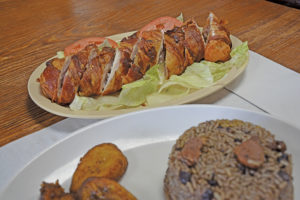 Pero antes que la fama llegara, Marín tuvo que reunir recetas, idear toques de distinción y captar clientela. Entonces no existían las redes sociales y el nuevo negocio no se podía dar el lujo de pagar publicidad.
Pero antes que la fama llegara, Marín tuvo que reunir recetas, idear toques de distinción y captar clientela. Entonces no existían las redes sociales y el nuevo negocio no se podía dar el lujo de pagar publicidad.
Un día, Marín preparó 20 panes con bisté, muy a su estilo, con la carne muy bien adobada encima de las papitas y el tomate, “para degustarlo mejor”; y los repartió por la barriada en Hialeah.
Algo similar hizo con el sándwich cubano. “Si pones lascas de pepinillo encurtido abajo, no vas a resolver nada. Muchas personas te van a decir, no tiene pepino. Y sin embargo tiene pepino”, explicó.
“Yo le pongo tres lascas arriba. Disfrutas más en tu paladar. Bueno, la cocina tiene muchos secretos, muchas cositas”, apuntó.
Otro día, Marín promocionó su lechón asado con arroz moro y yuca, y así, con la prueba en la mano, precios bajos y publicidad de boca en boca, logró que conocieran el nuevo restaurante Casa Marín.
“Dio mucho trabajo comenzar, pero creamos platos que donde único se dan bien es aquí en Casa Marín. Otros lugares lo harán, pero son copias”, resaltó.
Plato estrella
De esta manera, surgió un plato estrella, con un nombre picaresco, aunque accidental, ‘La cosita de Marín’.
“Estaba sentado al mostrador y dije ‘voy a preparar algo para comer’ y fui a la cocina. Cogí un bistec de pollo, lo machuqué y lo adobé con limón, ajo y sal. Le puse jamón y lo enrollé en forma de plátano con beicon por fuera y lo puse al horno, y después en la freidora para dorarlo. Lo corté en rueditas. Quedó bello. Quedó, como se dice, para fotografía”, detalló.
“¡A todos les gustó!”, exclamó.
En ese momento, entró una pareja de clientes al restaurante que no sabían qué pedir. “Le dimos a probar un pedacito de lo que hice y la señora de la pareja de clientes dijo ‘yo lo que quiero comer es la cosita esa de Marín’, y ese es el nombre que pusimos al plato aquel día, ‘La cosita de Marín’, y así se quedó”, relató entre risas.
“El plato pegó”, se popularizó, “traté de darlo a conocer por los medios que tenía. Entonces no había Facebook, así que repartí volantes por Hialeah, y la publicidad boca a boca ayudó mucho”, recordó.
Variedad
Además de comida cubana y platos estrellas, hay otros que celebran la cocina de la Madre Patria, España, al estilo de Marín.
En efecto, una buena parte de la cocina cubana tiene sus raíces en la española. “Mantenemos el caldo gallego, que gusta mucho, así como la fabada y otros platos que he adaptado, como cerdito madrileño que es un bistec de cerdo relleno con garbanzos fritos, chorizo, jamón y enrollado en beicon, y el fricasé de pollo a la catalana, que también es delicioso”, afirmó.
¿Cómo se hizo chef?
Marín llegó de Cuba en 1990. “Yo era licenciado en Deportes, pero revalidar el título y trabajar en eso aquí era muy difícil. Tendría que haber dominado el inglés. Llegué con mi esposa y dos hijos pequeños y tenía que trabajar”, acentuó.
Marín comenzó lavando platos en un restaurante. Luego trabajó en la cadena Latin American. “Allí aprendí mucho en la cocina. Serví platos, pero siempre fui una persona que le gusta ver más allá del lugar donde está parado. Ayudé al cocinero y aprendí a elaborar platos”, recordó.
En Cuba Marín tenía cierta noción de cocina. “Pero no es igual. Allí hacía chícharos con una cebolla y sal, pero aquí hay carne, chorizo y especias, y hay que aprender a combinar los ingredientes para darle un verdadero punto de sazón”, afirmó.
25 años
Según datos de la firma de estadísticas Xmap, en Miami-Dade hay cerca de 8.800 locales gastronómicos, lo que sitúa al área metropolitana de Florida entre las zonas punteras per cápita. Y, por ende, la gastronomía en esta región es un sector muy competitivo.
De hecho, Miami y sus alrededores cuenta con la segunda mayor variedad de restaurantes internacionales de Estados Unidos, solamente superado por Nueva York.
“Es un negocio muy difícil. De 100 restaurantes que abren en Miami-Dade, si acaso 15 o 20 logran sobrevivir”, señaló.
Con la típica ventanita cubana para café y órdenes para llevar, Casa Marín cuenta con mostrador y mesas bien situadas que acomodan hasta 55 comensales, en un ambiente jovial que lo hace precisamente popular.
“Yo digo que, además de la calidad y el precio de la comida, la relación entre propietario o mánager, empleado y cliente es fundamental. Traer un cliente al restaurante es muy difícil, pero perderlo es muy fácil”, aseguró.
Prueba de ello es la permanencia de empleados, que incluso, cuando trabajan en otro lugar, regresan como clientes.
“Al cliente hay que mirarlo como parte de la familia. Complacerlo dentro de las reglas del restaurante”, planteó.
¿Cómo? “Si hay un cliente que quiere el tomate cortado en cubitos y no en ruedas como acostumbramos, se le pica en cubitos. Si quiere el potaje colado, hay restaurantes que dicen redondamente que no. Cuesta algo más de tiempo y quedará menos caldo en la cocina, que significa dinero, pero se puede hacer. Se le dice al cliente ‘$2.25 sin colar y $3 colado’. ¿Cómo saldría el cliente más contento? ¿Qué le den una solución o que le digan no?”, reflexionó.
Lo mismo sucede con la crema de malanga. “Muchos restaurantes la hacen con caldo de pollo, pero si el cliente la quiere con leche o queso crema, por qué no hacerla a la orden cuando tienen leche o queso crema”, sopesó.
“Esas son las pequeñas cosas que hacen sentir al cliente satisfecho. Son las cositas que hacen que el cliente regrese al restaurante”, realzó.

